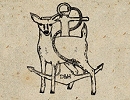Contact Seller
Doe And Hope
Tel07729 213013Please quote Antiques Atlas.


 Alabaster Bust of a Renaissance Woman c.1900
Alabaster Bust of a Renaissance Woman c.1900
 A Good Classical Weathered Bust of a Lady
A Good Classical Weathered Bust of a Lady
 Terracotta Bust of A Young Man
Terracotta Bust of A Young Man
 Parian bust Queen Victoria
Parian bust Queen Victoria
 John Milton, bronze bust.
John Milton, bronze bust.
 Large fine quality marble bust of James Loch MP
Large fine quality marble bust of James Loch MP
 Heavy Vintage Bohemian Female Bust, Continental
Heavy Vintage Bohemian Female Bust, Continental
 Bronze Bust of a Young Woman by Lambeaux c.1900
Bronze Bust of a Young Woman by Lambeaux c.1900
 Jean Racine, Barbedienne bust
Jean Racine, Barbedienne bust
 19th Century Gilt Bronze Bust 'Le Petit Roi'
19th Century Gilt Bronze Bust 'Le Petit Roi'
 Large Plaster Bust of a Gentleman c.1900
Large Plaster Bust of a Gentleman c.1900
 Henry Wissen 1894-1914 French Bronze Maiden Bust
Henry Wissen 1894-1914 French Bronze Maiden Bust
Non UK callers :
+44 7729 213013
Super Group of 5 Plaster Classical Portrait Heads


The highly decorative group of five well modeled studio portrait heads worked in composition plaster, after the antique, each depicting important figures from classical antiquity being two male and three female, and surviving from the second half of the twentieth century.
The condition of the head studies is generally good with expected scuffs and chips commensurate with age and use to them overall. The head of Artemis has a chip to one side of the top and bottom edge. The painted surface to Demeter of Knidos has additional dirt and some peeling of the paint with a possible repair to her lips. There are chips to the hair and eyebrows to most of the heads. In terms of display, three of the five sit at jaunty angles. The three female studies are freestanding, (though Artemis has to sit in a certain fashion) whilst in terms of the males, the Capitoline Antinous needs supporting to one side (we have used a plate stand), and the Arundel Head is freestanding but again sits at a certain angle.
The portrait studies depict, in our opinion, the following figures:
- Demeter of Knidos
The Demeter of Knidos is a life-size, seated ancient Greek statue that was discovered in the port of Knidos, south-west Asia Minor (present-day Turkey). Now part of the British Museum's collection, it is an impressive example of Hellenistic sculpture from around 350 BC.
- Arundel Head (Possibly Sophocles)
The Arundel Head is an Hellenistic bronze portrait of a dramatist or king from Asia Minor, now kept in the British Museum. Dating to the 2nd-1st centuries BC, the head once belonged to (and takes its name from) the famous English collector of classical antiquities, Thomas Howard, 21st Earl of Arundel.
- Artemis
Artemis was one of the most widely venerated of the Ancient Greek deities. Her Roman equivalent is Diana. Some scholars believe that the name, and indeed the goddess herself, was originally pre-Greek. Homer refers to her as Artemis Agrotera, Potnia Theron: "Artemis of the wildland, Mistress of Animals". The Arcadians believed she was the daughter of Demeter.
- Capitoline Antinous
The Capitoline 'Antinous' is a marble statue of a young nude male found at Hadrian's Villa, Tivoli, during the time when Conte Giuseppe Fede was undertaking the earliest concerted excavations there. It was bought before 1733 by Alessandro Cardinal Albani. To contemporaries it seemed to be the real attraction of his collection. The statue was bought by Pope Clement XII in 1733 and went on to form the nucleus of the Capitoline Museums, Rome, where it remains
- Dante's Beatrice
Beatrice "Bice" di Folco Portinari) was a Florentine woman who has been commonly identified as the principal inspiration for Dante Alighieri's Vita Nuova, and is also commonly identified with the Beatrice who appears as one of his guides in the Divine Comedy (La Divina Commedia) in the last book, Paradiso, and in the last four cantos of Purgatorio.
When grouped together this beautiful quintet sing very harmoniously and deliver superb decorative punch.
With thanks to Andrea Swinton
The Largest: 16” high x 9” deep x 10” wide
The Smallest: 12” high x 9” deep x 8.5” wide
Other measurements available on request
SellerDoe And Hope
View all stock from
Doe And Hope

 Private dealer, By appointment only
Private dealer, By appointment only
The Onion Barn, Shoe Cottage,
15 High Street, Blunham,
Bedfordshire, MK44 3NL.
MK44 3NL
Tel : 07729 213013
Non UK callers : +44 7729 213013
Get directions to Doe And Hope
The condition of the head studies is generally good with expected scuffs and chips commensurate with age and use to them overall. The head of Artemis has a chip to one side of the top and bottom edge. The painted surface to Demeter of Knidos has additional dirt and some peeling of the paint with a possible repair to her lips. There are chips to the hair and eyebrows to most of the heads. In terms of display, three of the five sit at jaunty angles. The three female studies are freestanding, (though Artemis has to sit in a certain fashion) whilst in terms of the males, the Capitoline Antinous needs supporting to one side (we have used a plate stand), and the Arundel Head is freestanding but again sits at a certain angle.
The portrait studies depict, in our opinion, the following figures:
- Demeter of Knidos
The Demeter of Knidos is a life-size, seated ancient Greek statue that was discovered in the port of Knidos, south-west Asia Minor (present-day Turkey). Now part of the British Museum's collection, it is an impressive example of Hellenistic sculpture from around 350 BC.
- Arundel Head (Possibly Sophocles)
The Arundel Head is an Hellenistic bronze portrait of a dramatist or king from Asia Minor, now kept in the British Museum. Dating to the 2nd-1st centuries BC, the head once belonged to (and takes its name from) the famous English collector of classical antiquities, Thomas Howard, 21st Earl of Arundel.
- Artemis
Artemis was one of the most widely venerated of the Ancient Greek deities. Her Roman equivalent is Diana. Some scholars believe that the name, and indeed the goddess herself, was originally pre-Greek. Homer refers to her as Artemis Agrotera, Potnia Theron: "Artemis of the wildland, Mistress of Animals". The Arcadians believed she was the daughter of Demeter.
- Capitoline Antinous
The Capitoline 'Antinous' is a marble statue of a young nude male found at Hadrian's Villa, Tivoli, during the time when Conte Giuseppe Fede was undertaking the earliest concerted excavations there. It was bought before 1733 by Alessandro Cardinal Albani. To contemporaries it seemed to be the real attraction of his collection. The statue was bought by Pope Clement XII in 1733 and went on to form the nucleus of the Capitoline Museums, Rome, where it remains
- Dante's Beatrice
Beatrice "Bice" di Folco Portinari) was a Florentine woman who has been commonly identified as the principal inspiration for Dante Alighieri's Vita Nuova, and is also commonly identified with the Beatrice who appears as one of his guides in the Divine Comedy (La Divina Commedia) in the last book, Paradiso, and in the last four cantos of Purgatorio.
When grouped together this beautiful quintet sing very harmoniously and deliver superb decorative punch.
With thanks to Andrea Swinton
The Largest: 16” high x 9” deep x 10” wide
The Smallest: 12” high x 9” deep x 8.5” wide
Other measurements available on request
Price The price has been listed in British Pounds.
Conversion rates as of 10/JUN/2025. Euro & Dollar prices will vary and should only be used as a guide.
Always confirm final price with dealer. Phone or visit the website to buy, Free UK shipping.
Category Busts and Figures
Date c.1960-70
Retro Antiques Material Plaster
Origin English
Item code as155a1615 / 1668
Status Sold
£2650.00 
$3581.48 
€3134.95 

$

€

Conversion rates as of 10/JUN/2025. Euro & Dollar prices will vary and should only be used as a guide.
Always confirm final price with dealer. Phone or visit the website to buy, Free UK shipping.
View all stock from
Doe And Hope

 Private dealer, By appointment only
Private dealer, By appointment onlyThe Onion Barn, Shoe Cottage,
15 High Street, Blunham,
Bedfordshire, MK44 3NL.
MK44 3NL
Tel : 07729 213013
Non UK callers : +44 7729 213013
Get directions to Doe And Hope
You may also be interested in
 Alabaster Bust of a Renaissance Woman c.1900
Alabaster Bust of a Renaissance Woman c.1900
 A Good Classical Weathered Bust of a Lady
A Good Classical Weathered Bust of a Lady
 Terracotta Bust of A Young Man
Terracotta Bust of A Young Man
 Parian bust Queen Victoria
Parian bust Queen Victoria
 John Milton, bronze bust.
John Milton, bronze bust.
 Large fine quality marble bust of James Loch MP
Large fine quality marble bust of James Loch MP
 Heavy Vintage Bohemian Female Bust, Continental
Heavy Vintage Bohemian Female Bust, Continental
 Bronze Bust of a Young Woman by Lambeaux c.1900
Bronze Bust of a Young Woman by Lambeaux c.1900
 Jean Racine, Barbedienne bust
Jean Racine, Barbedienne bust
 19th Century Gilt Bronze Bust 'Le Petit Roi'
19th Century Gilt Bronze Bust 'Le Petit Roi'
 Large Plaster Bust of a Gentleman c.1900
Large Plaster Bust of a Gentleman c.1900
 Henry Wissen 1894-1914 French Bronze Maiden Bust
Henry Wissen 1894-1914 French Bronze Maiden Bust







